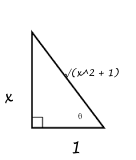How do you integrate #int x/sqrt(x^2+1)# by trigonometric substitution?
2 Answers
Explanation:
Let
#=> int tan theta/sqrt((tan^2theta + 1)) sec^2theta d theta#
#=> int tantheta/sqrt(sec^2theta) sec^2theta d theta#
#=> int tantheta/sectheta sec^2theta d theta#
#=> int tan theta sec theta d theta#
This is a common integral--
#=> sec theta + C#
We now draw an imaginary triangle.

The definition of
Therefore, the integral can be simplified to
Hopefully this helps!
By inspection rather than trig substitution.
Explanation:
Notice that the
Alternatively substitute

